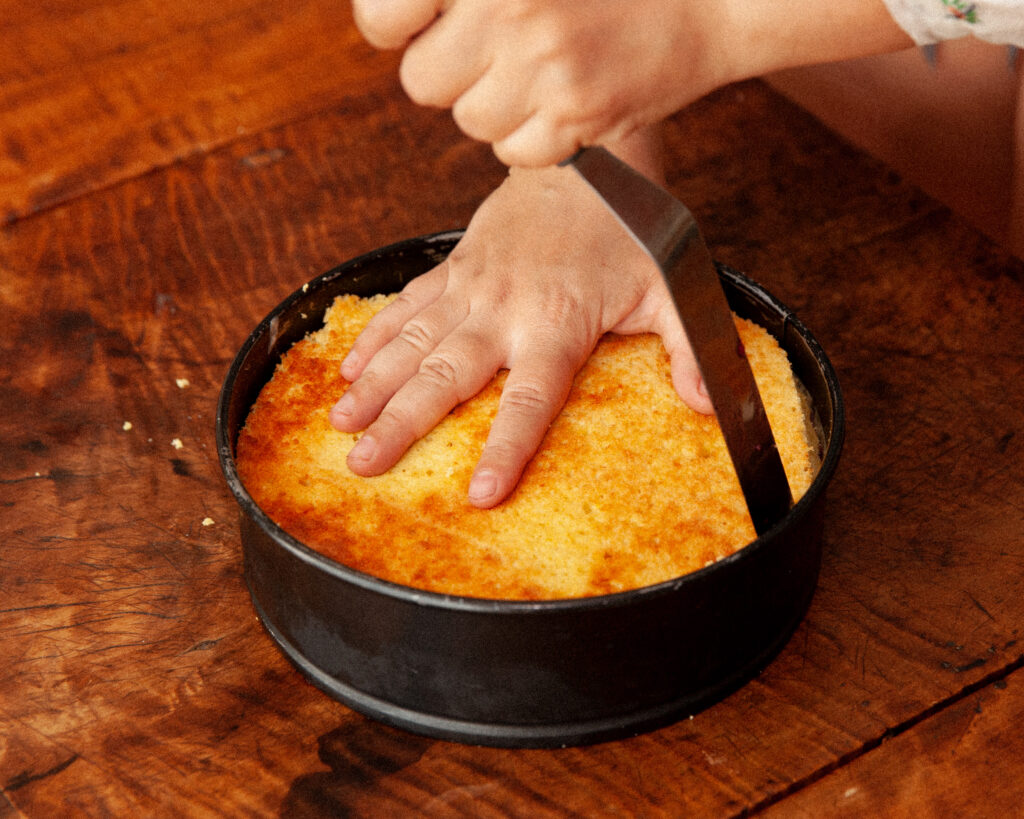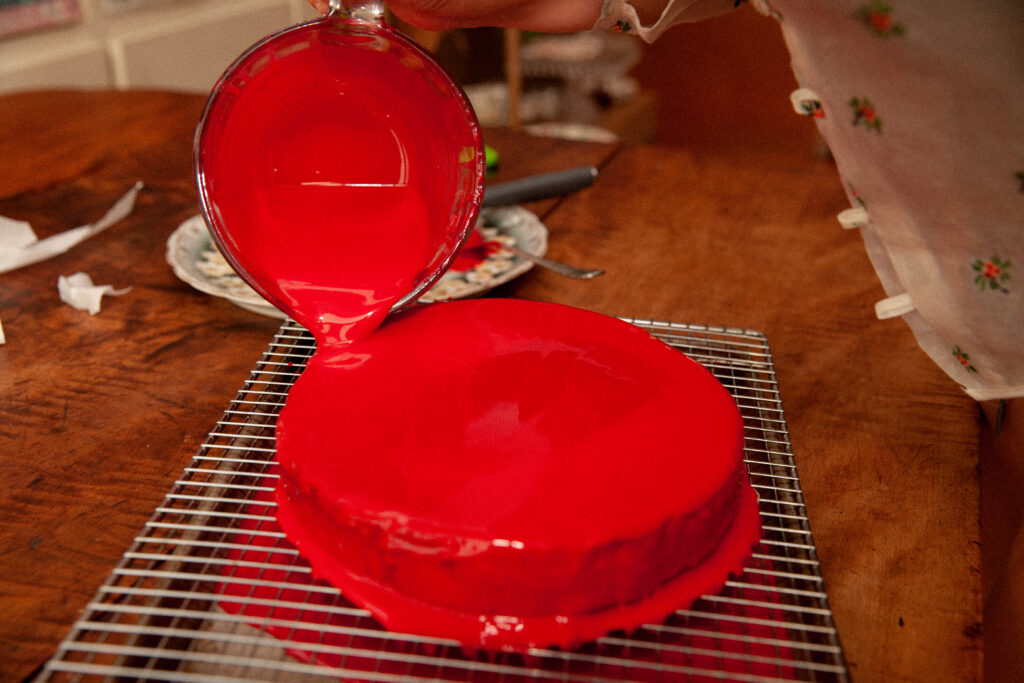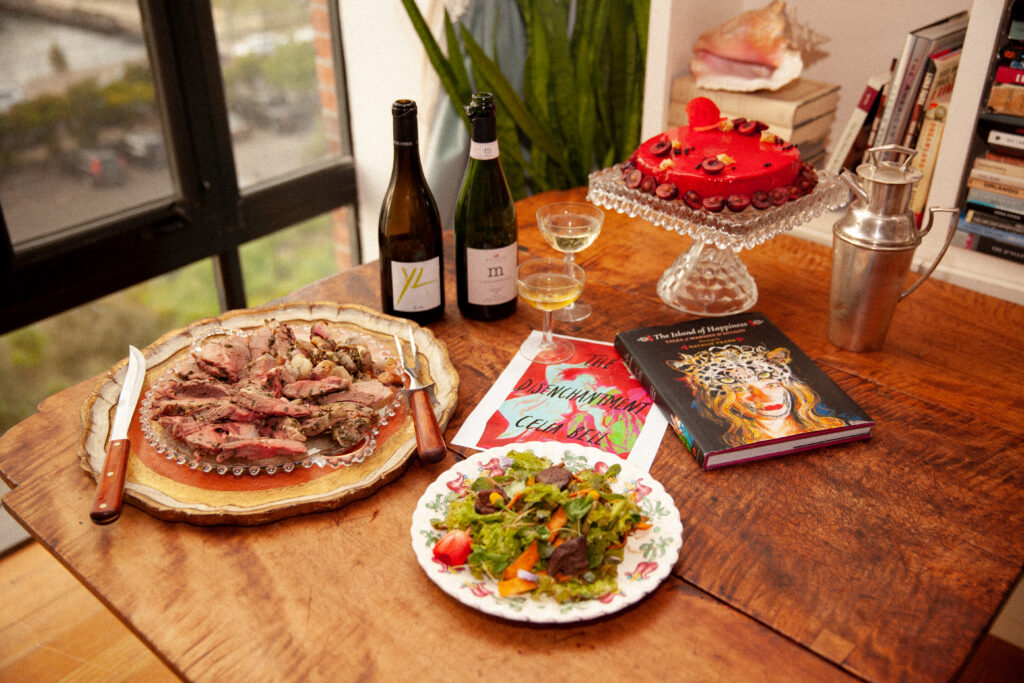Photograph by Erica Maclean.
Make the mousse. Purée the cherries with the sugar, then add the cherry liquid or cognac and bring to a simmer in a small saucepan. Remove from the heat and allow to cool. Whisk the egg yolks and remaining sugar together in a saucepan over low heat, stirring continuously (your goal is to temper the eggs and prevent them from curdling). When the egg mixture is warm and has begun to look creamy, whisk in about 1/4 cup of the cherry purée and heat through. It should thicken slightly.
Meanwhile, bloom the gelatin: Add two packets to 40 ml of cool water. The powder will expand and become gelatinous. Whisk the bloomed gelatin into the egg-and-cherries mixture, then add the rest of the puréed cherries and mix thoroughly. Allow the whole mixture to cool to room temperature. Do not under any circumstances add the mixture to the whipped cream (next step) before it is completely cool.
Once the egg-cherries-and-gelatin mixture has cooled (or while you are waiting for it to cool), whip the cream into stiff peaks. Gently fold the mixture into the whipped cream, being careful not to knock the air out of the cream. Pour the mousse into a greased, parchment-lined springform pan and transfer to the refrigerator to set. The mousse may set in just a few hours, but I recommend doing this step the night before you want to serve the cake, to avoid anxiety.

Photograph by Erica Maclean.
Make the cake. Preheat the oven to 350°F. Line a sheet pan with parchment paper. The batter is quite stiff and the cake layer will be thin, so don’t worry too much about lining the sides. You do, however, need to choose a baking sheet that has more surface area than the springform pan you used for the mousse, as you will cut out the cake to the precise size you need after it’s baked.
Add the egg whites and cream of tartar to the bowl of an electric mixer and beat until they form soft peaks. Add the powdered sugar and continue to beat until the meringue forms stiff, glossy peaks. Set aside, and in a separate bowl beat the whole eggs and sugar until light and fluffy, then add the butter, orange blossom water, and orange zest and mix thoroughly. Gently fold in the almond meal and flour, and then fold this mixture gently into your meringue. As with the mousse, be careful not to knock the air out of your batter as you are folding. This cake has no chemical rising agent—it relies on the air trapped in your meringue to make it light and fluffy.
Using a spatula, spread your cake batter out onto your prepared baking sheet. You can make it as thick or as thin as you like; I spread it about one inch thick. You do not need to spread it all the way to the edges of the pan. Bake for fifteen to twenty minutes, or until the top turns golden brown and the cake is firm and springy to the touch. Allow it to cool completely.
To assemble the cake, take your springform pan with the set mousse and place it on top of the almond cake and trace the outline of the pan. Trim your cake in this shape: it should fit nicely into the top of your pan. Next, spread the rest of the cherry purée on top of the set mousse. Prepare a baking dish full of warm water large enough to hold your pan—an inch or two of water will be enough; don’t flood your cake. Place the sponge cake layer on top of the mousse pan, and place the pan in the warm-water bath for thirty seconds. Then place baking sheet on top of the pan and carefully flip it. Working slowly, remove the sides of your springform pan and then the top, being careful not to tear or dent the mousse layer. The mousse should hold its shape. Put in the freezer for thirty minutes or overnight.

Photograph by Erica Maclean.
Make the mirror glaze. Bloom the gelatin: Mix the gelatin and cold water and set aside until the gelatin expands. Meanwhile, whisk together the condensed milk, water, and sugar in a small pot. Bring to a simmer over medium-high heat, then whisk in the bloomed gelatin until it is fully dissolved and no clumps remain. (I suggest using an immersion blender for this step, but be careful to keep it fully submerged, so you don’t introduce bubbles into the glaze.)
Place the white chocolate in a mixing bowl, then pour the hot gelatin mixture through a sieve over the chocolate. The chocolate should melt completely. Mix with an immersion blender, and add red food coloring until you have a bright, shiny red. Transfer to a vessel that pours easily and allow to cool to 94°F, monitoring the temperature closely. The mirror glaze will set correctly if poured between 90 and 94°F. If it is too hot or too cold, you will not achieve the desired effect.
While you are waiting for the glaze to cool, prepare the mousse cake for glazing. Remove it from the freezer, and using an offset spatula, transfer it to a cake stand or cooling rack set over a baking sheet (the glaze will be messy—you want to catch any drips). When the glaze reaches 94°F, slowly pour it over your cake, starting at the center. The glaze should pool and drip down the sides. Continue to pour until you’ve used all the glaze, taking care to coat the whole cake evenly. The glaze should set within one or two minutes. Once it has set, use the spatula to carefully transfer the cake to a serving platter.
Garnish. I sliced my cherries in half and arranged them on the cake with the pits still in, to look like broken hearts. Cut small pieces of comb honey to go in between them, and garnish with a few red flowers.

Photograph by Erica Maclean.
Valerie Stivers is a writer based in New York. Read earlier installments of Eat Your Words.
